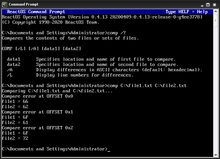 The
ReactOS comp command | |
| Developer(s) | DEC, IBM, Microsoft, Digital Research, Novell, Paul Vojta, ReactOS Contributors |
|---|---|
| Initial release | August 1981 |
| Operating system | OS/8, PC DOS, MS-DOS, FlexOS, SISNE plus, OS/2, eComStation, ArcaOS, Windows, DR DOS, FreeDOS, ReactOS |
| Platform | Cross-platform |
| Type | Command |
| License | FreeDOS:
MIT ReactOS: GNU GPL 2 |
In
computing, comp is a
command used on
DEC
OS/8,
[1]
DOS,
[2]
DR
FlexOS,
[3]
IBM
OS/2,
[4]
Microsoft
Windows
[5] and related computer
operating systems such as
ReactOS. It is used to perform comparisons of multiple
computer files to show the differences between them.
[6]
History

COMP.COM (among other commands) in
IBM PC DOS 1.0.In DOS, the comp command first appeared in PC DOS 1.0
[7] and has been included in most versions of
MS-DOS and
PC DOS. A newer command,
fc was added in DOS 3.3 which allows for line comparisons in addition to binary comparisons.
DR DOS 6.0 also includes an implementation of the comp command.
[8]
The FreeDOS version was developed by Paul Vojta and is licensed under the MIT License. [9] Ged Murphy developed the ReactOS version. It is licensed under the GNU GPL 2. [10]
The command is also available in the EFI shell. [11]
Syntax
comp [<Data1>] [<Data2>] [/d] [/a] [/l] [/n=<Number>] [/c]
Parameters
<Data1>– Location and name of the first file or set of files<Data2>– Location and name of the second file or set of files/d– Display differences in decimal format (Default is hexadecimal)/a– Display differences as characters/l– Display the number of the line, instead of the byte offset/n=<Number>– Compare only the specified number of lines for each file/c– Perform a non case-sensitive comparison/off[line]– Process files with the offline attribute set/?– Display Help
See also
References
- ^ "Concise Command Language" (CCL). "OS/8 Handbook" (PDF). April 1974. Retrieved 28 November 2017.
- ^ Jamsa, Kris A. (1993), DOS: The Complete Reference, Osborne McGraw-Hill, p. 206, ISBN 0078819040.
- ^ http://www.bitsavers.org/pdf/digitalResearch/flexos/1073-2003_FlexOS_Users_Guide_V1.3_Nov86.pdf Archived 2019-09-25 at the Wayback Machine [ bare URL PDF]
- ^ "OS/2 Commands". www.jatomes.com. Archived from the original on 2019-04-14. Retrieved 2019-07-20.
- ^ "Comp".
- ^ Wolverton, Van (2003). Running MS-DOS Version 6.22 (20th Anniversary Edition), 6th Revised edition. Microsoft Press. ISBN 0-7356-1812-7.
- ^ http://www.bitsavers.org/pdf/ibm/pc/dos/6172220_DOS_1.0_Jan82.pdf [ bare URL PDF]
- ^ "DR DOS 6.0 User Guide Optimisation and Configuration Tips" (PDF). Archived from the original (PDF) on 2019-09-30. Retrieved 2019-08-13.
- ^ "FreeDOS 1.2 Updates Package - comp (FreeDOS Base)". Ibiblio.org. 2006-10-21. Retrieved 2022-09-04.
- ^ "Reactos/Reactos". GitHub. 3 January 2022.
- ^ "EFI Shells and Scripting". Intel. Retrieved 2013-09-25.
- ^ MS-DOS and Windows command line comp command
Further reading
- Cooper, Jim (2001). Special Edition Using MS-DOS 6.22, Third Edition. Que Publishing. ISBN 978-0789725738.
- Dyson, Peter (1995). Mastering OS/2 Warp. Sybex. ISBN 978-0782116632.
- Stanek, William R. (2008). Windows Command-Line Administrator's Pocket Consultant, 2nd Edition. Microsoft Press. ISBN 978-0735622623.
External links
 The
ReactOS comp command | |
| Developer(s) | DEC, IBM, Microsoft, Digital Research, Novell, Paul Vojta, ReactOS Contributors |
|---|---|
| Initial release | August 1981 |
| Operating system | OS/8, PC DOS, MS-DOS, FlexOS, SISNE plus, OS/2, eComStation, ArcaOS, Windows, DR DOS, FreeDOS, ReactOS |
| Platform | Cross-platform |
| Type | Command |
| License | FreeDOS:
MIT ReactOS: GNU GPL 2 |
In
computing, comp is a
command used on
DEC
OS/8,
[1]
DOS,
[2]
DR
FlexOS,
[3]
IBM
OS/2,
[4]
Microsoft
Windows
[5] and related computer
operating systems such as
ReactOS. It is used to perform comparisons of multiple
computer files to show the differences between them.
[6]
History

COMP.COM (among other commands) in
IBM PC DOS 1.0.In DOS, the comp command first appeared in PC DOS 1.0
[7] and has been included in most versions of
MS-DOS and
PC DOS. A newer command,
fc was added in DOS 3.3 which allows for line comparisons in addition to binary comparisons.
DR DOS 6.0 also includes an implementation of the comp command.
[8]
The FreeDOS version was developed by Paul Vojta and is licensed under the MIT License. [9] Ged Murphy developed the ReactOS version. It is licensed under the GNU GPL 2. [10]
The command is also available in the EFI shell. [11]
Syntax
comp [<Data1>] [<Data2>] [/d] [/a] [/l] [/n=<Number>] [/c]
Parameters
<Data1>– Location and name of the first file or set of files<Data2>– Location and name of the second file or set of files/d– Display differences in decimal format (Default is hexadecimal)/a– Display differences as characters/l– Display the number of the line, instead of the byte offset/n=<Number>– Compare only the specified number of lines for each file/c– Perform a non case-sensitive comparison/off[line]– Process files with the offline attribute set/?– Display Help
See also
References
- ^ "Concise Command Language" (CCL). "OS/8 Handbook" (PDF). April 1974. Retrieved 28 November 2017.
- ^ Jamsa, Kris A. (1993), DOS: The Complete Reference, Osborne McGraw-Hill, p. 206, ISBN 0078819040.
- ^ http://www.bitsavers.org/pdf/digitalResearch/flexos/1073-2003_FlexOS_Users_Guide_V1.3_Nov86.pdf Archived 2019-09-25 at the Wayback Machine [ bare URL PDF]
- ^ "OS/2 Commands". www.jatomes.com. Archived from the original on 2019-04-14. Retrieved 2019-07-20.
- ^ "Comp".
- ^ Wolverton, Van (2003). Running MS-DOS Version 6.22 (20th Anniversary Edition), 6th Revised edition. Microsoft Press. ISBN 0-7356-1812-7.
- ^ http://www.bitsavers.org/pdf/ibm/pc/dos/6172220_DOS_1.0_Jan82.pdf [ bare URL PDF]
- ^ "DR DOS 6.0 User Guide Optimisation and Configuration Tips" (PDF). Archived from the original (PDF) on 2019-09-30. Retrieved 2019-08-13.
- ^ "FreeDOS 1.2 Updates Package - comp (FreeDOS Base)". Ibiblio.org. 2006-10-21. Retrieved 2022-09-04.
- ^ "Reactos/Reactos". GitHub. 3 January 2022.
- ^ "EFI Shells and Scripting". Intel. Retrieved 2013-09-25.
- ^ MS-DOS and Windows command line comp command
Further reading
- Cooper, Jim (2001). Special Edition Using MS-DOS 6.22, Third Edition. Que Publishing. ISBN 978-0789725738.
- Dyson, Peter (1995). Mastering OS/2 Warp. Sybex. ISBN 978-0782116632.
- Stanek, William R. (2008). Windows Command-Line Administrator's Pocket Consultant, 2nd Edition. Microsoft Press. ISBN 978-0735622623.
External links